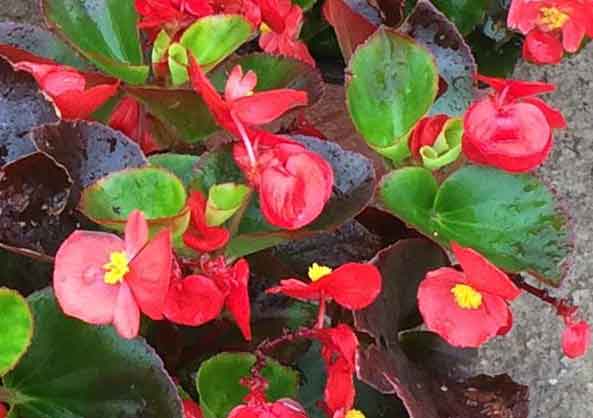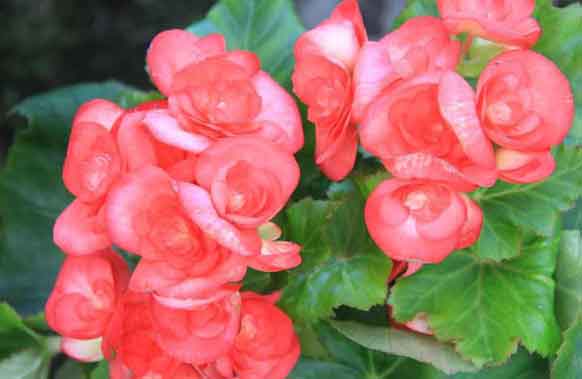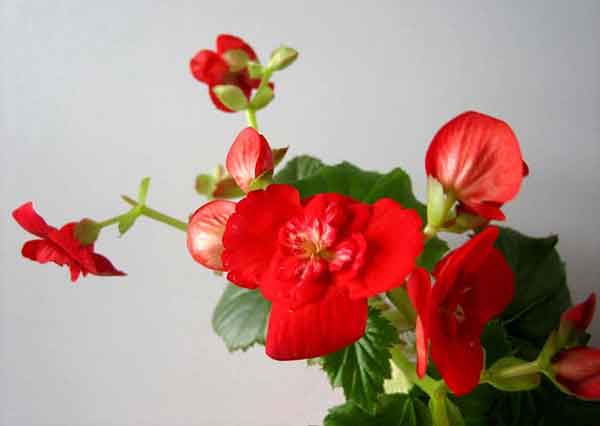Wax Begonias Profile
Written by Iris
Oct 14 2021

The Wax Begonia (Begonia Semperflorens-Cultorum) is a group of beautiful Begonia plants with green, bronze or reddish brown waxy leaves that grow in compact, dense mounds. Wax begonias are popular bedding plants that grow as annuals or warm weather perennials. Growing in dappled sunlight, spreading, low bedding Wax Begonias produce clusters of white, pink or red flowers that bloom from summer through fall.

The plants stand from six inches to two feet high and feature compact growth with oval-shaped, glossy leaves. The foliage is typically uniform and green, though some varieties have bronze-tinged or reddish leaves. Variegated cultivars also exist.
The Wax Begonia won't tolerate a frost, but it adapts well to being brought indoors for overwintering. They have a fibrous root system and a mild resistance to brief droughts, and aren't particularly troubled by pests or disease.
1. About 12 weeks before the last frost, start your seeds indoors. Sprinkle seeds on well-draining, rich soil.
2. Simply press the seeds gently into the soil with your finger, making sure they are not covered over. They need bright light to germinate.
3. Cover the seeds with a plastic bag or humidity dome and keep the soil moist.
4. Patience is key here. Begonias take a long time to germinate, so don’t give up.
5. Keep your seeds warm with grow lights and keep watch on them. Placing them on a heating mat may help them germinate as well.
6. Once they get their first set of true leaves, you can transplant your baby wax begonias to their own containers and harden them off before planting them up outside.
1. With a clean pair of snips, cut a three to four-inch sprig from your wax begonia in the spring. Be sure the cutting has a few nodes on it.
2. Remove the bottom leaves about two inches from the bottom.
3. Dip the cut end into a rooting hormone.
4. Bury the cut end around two inches into well-draining soil and keep the soil moist. You could additionally place a plastic bag over the plant to keep in the moisture while it is forming roots.
Alternatively, you can skip steps three and four by simply placing your cutting into a jar of water and waiting until roots appear. Once the roots are about an inch or so long, transfer your cutting to dirt, and you’ve got a new little plant.
Wax Begonias ‘Super Olympia’: This is a variety that flowers early and is known for large, white, pink, or red blooms.
Wax Begonias 'Varsity’: This cultivar is especially good for growing in pots. Its flowers are red, white, or pink.
Wax Begonias ‘Paint Splash Pink’: This variety offers showy foliage, green with cream spots and marks. It has unique pale pink flowers.
Wax Begonias 'Victory series': This group has bronze-colored leaves with large, showy flowers.
Wax Begonias ''Cocktail series': These are dwarf varieties, 6 to 8 inches tall.
Stem rot
It is a fungal disease caused by a variety of fungal pathogens like Pythium, Rhizoctonia, Botrytis. The stem rot caused by Botrytis causes the stem to become soft, brown, and gray fuzzy Botrytis spores. Rhizoctonia stem rot causes webbing and sunken brown dry spots on the stem. The plants infected with Pythium show small discolored roots and tubers and blackened stems.
Powdery mildew
It is a fungal disease caused due to excess moisture on the surface of the leaves. A white powdery layer is formed on the surface of the leaves, preventing the entry of sunlight. The infected leaves wilt and die.
Gray mold
It is a fungal disease where Brown Spots are seen on the surface of leaves and flowers, the stem becomes soft and rotted.
Whiteflies and spider mites can cause the leaves to turn yellow. Slugs and snails can lead to holes in the leaves.
Trailing and mounding varieties look great in pots, window boxes, and hanging baskets.
Use upright varieties with unique foliage for a container centerpiece.
Mix-n-match plants with contrasting leaf colors, shapes, and textures for a unique container combination.
Select darker-leaved varieties or types with improved heat and sun tolerance for sunnier spots.
Search container combinations that include begonias.
Wax Begonias PictureWax Begonias InfoWax Begonia HistoryEcological Habits of Wax BegoniasWax Begonias Distribution AreaHow to Grow and Care for Wax BegoniasHow to Grow Wax BegoniasHow to Care for Wax BegoniasUses of Wax BegoniasVarieties of Wax BegoniasWax Begonias Common Pests/DiseasesWax Begonias Design TipsWax Begonias Companion Plants
Wax Begonias Picture

Wax Begonias Info
| Botanical Name | Begonia (Semperflorens Cultorum Group) |
| Common Name | Wax begonia |
| Plant Type | Herbaceous perennial (frequently planted as an annual) |
| Mature Size | 6–12 inches |
| Sun Exposure | Full sun to part shade |
| Soil Type | Moist, well-drained soil |
| Soil pH | 5.5–6.5 (slightly acidic) |
| Bloom Time | Summer into fall |
Wax Begonia History
The origin of the Wax Begonias was ordinarily thought to be in Brazil, although some were found in the North American country at an earlier date. Therefore the Chinese used them within the 14th century. However, the primary person to document the invention of Wax Begonias was a Franciscan monk, Charles Plumier, who found fibrous wax begonias in Brazil in 1690.Ecological Habits of Wax Begonias
The Wax Begonia thrives equally well as a houseplant or an outdoor annual; in warm climates, it can be grown as a perennial. Their natural summer-long flowering season can be extended indefinitely indoors in a sunny windowsill. They bloom in clusters of red, white, yellow, or pink flowers, and some varieties are pleasantly fragrant.The plants stand from six inches to two feet high and feature compact growth with oval-shaped, glossy leaves. The foliage is typically uniform and green, though some varieties have bronze-tinged or reddish leaves. Variegated cultivars also exist.
The Wax Begonia won't tolerate a frost, but it adapts well to being brought indoors for overwintering. They have a fibrous root system and a mild resistance to brief droughts, and aren't particularly troubled by pests or disease.
Wax Begonias Distribution Area
Wax Begonias are indigenous to tropical and subtropical regions; no species is native to the United States. Wax Begonias occur primarily in Central and South America, Asia, and sub-Saharan Africa. The natural habitat of many begonias are moist, cool forests and tropical rainforests, but some begonias are adapted to dryer climates.
How to Grow and Care for Wax Begonias
How to Grow Wax Begonias
- With Seeds
1. About 12 weeks before the last frost, start your seeds indoors. Sprinkle seeds on well-draining, rich soil.
2. Simply press the seeds gently into the soil with your finger, making sure they are not covered over. They need bright light to germinate.
3. Cover the seeds with a plastic bag or humidity dome and keep the soil moist.
4. Patience is key here. Begonias take a long time to germinate, so don’t give up.
5. Keep your seeds warm with grow lights and keep watch on them. Placing them on a heating mat may help them germinate as well.
6. Once they get their first set of true leaves, you can transplant your baby wax begonias to their own containers and harden them off before planting them up outside.
- With Stem Cuttings
1. With a clean pair of snips, cut a three to four-inch sprig from your wax begonia in the spring. Be sure the cutting has a few nodes on it.
2. Remove the bottom leaves about two inches from the bottom.
3. Dip the cut end into a rooting hormone.
4. Bury the cut end around two inches into well-draining soil and keep the soil moist. You could additionally place a plastic bag over the plant to keep in the moisture while it is forming roots.
Alternatively, you can skip steps three and four by simply placing your cutting into a jar of water and waiting until roots appear. Once the roots are about an inch or so long, transfer your cutting to dirt, and you’ve got a new little plant.
How to Care for Wax Begonias
- Light
- Soil
- Water
- Temperature and Humidity
- Fertilizer
- Pruning

Uses of Wax Begonias
Wax Begonias lend themselves to large, formal plantings because of their uniform size and shapeliness. Wax Begonias are also suitable in front of summer annual borders and combine well with other cool-colored flowers in mixed plantings and containers.Varieties of Wax Begonias
Some popular cultivars include:Wax Begonias ‘Super Olympia’: This is a variety that flowers early and is known for large, white, pink, or red blooms.
Wax Begonias 'Varsity’: This cultivar is especially good for growing in pots. Its flowers are red, white, or pink.
Wax Begonias ‘Paint Splash Pink’: This variety offers showy foliage, green with cream spots and marks. It has unique pale pink flowers.
Wax Begonias 'Victory series': This group has bronze-colored leaves with large, showy flowers.
Wax Begonias ''Cocktail series': These are dwarf varieties, 6 to 8 inches tall.

Wax Begonias Common Pests/Diseases
Wax Begonias are not prone to many diseases or pests. Overwatering and overhead watering can result in fungal diseases like leaf spots and root rot. Avoid excess moisture in the soil and on the surface of the plants. Water the plants at the base.Stem rot
It is a fungal disease caused by a variety of fungal pathogens like Pythium, Rhizoctonia, Botrytis. The stem rot caused by Botrytis causes the stem to become soft, brown, and gray fuzzy Botrytis spores. Rhizoctonia stem rot causes webbing and sunken brown dry spots on the stem. The plants infected with Pythium show small discolored roots and tubers and blackened stems.
Powdery mildew
It is a fungal disease caused due to excess moisture on the surface of the leaves. A white powdery layer is formed on the surface of the leaves, preventing the entry of sunlight. The infected leaves wilt and die.
Gray mold
It is a fungal disease where Brown Spots are seen on the surface of leaves and flowers, the stem becomes soft and rotted.
Whiteflies and spider mites can cause the leaves to turn yellow. Slugs and snails can lead to holes in the leaves.

Wax Begonias Design Tips
Wax begonias make a colorful, compact edging for flower beds.Trailing and mounding varieties look great in pots, window boxes, and hanging baskets.
Use upright varieties with unique foliage for a container centerpiece.
Mix-n-match plants with contrasting leaf colors, shapes, and textures for a unique container combination.
Select darker-leaved varieties or types with improved heat and sun tolerance for sunnier spots.
Search container combinations that include begonias.
Wax Begonias Companion Plants
Wax begonias are often seen as the classic hanging basket or container plant. The small plants flower quickly and never get too large for their container. Hang the baskets where they get some sun and away from the roof edge where they might get drown in water during a storm. In the garden, plant wax begonias under trees or in front of shady flower or shrub borders to brighten up a dark area. They look best planted together in masses to create a flowering, ground cover effect.
Latest Updated
- Benefits of Bugleweed - 7 Science-backed Health Benefits
- Bugleweed Dangers & Side Effects - Is It Poisonous?
- How to Plant Evergreen Trees - What You Should Know
- When to Plant Evergreens - Grow Guide for Evergreen Trees
- 12 Wonderful Evergreen Shrubs for Your Garden
- 12 Popular Evergreen Plants with Pictures for Beginners
- When And How To Prune A Lilac Bush Like a Pro
- How to Grow & Care for Lilac Vine (Hardenbergia Violacea)
- Japanese Lilac Tree (Syringa Reticulata) Care & Propagation Guide
- Shumard Oak Pros and Cons - What to Know
Popular Articles
- Winter maintenance of Antirrhinum Majus
- How to Grow Terminalia Mantaly Tree
- How to Grow and Care for Crossostephium Chinense
- How to grow Antirrhinum Majus in spring
- Peristeria Elata (Dove Orchid) Profile: Info & Care Guide
- Underwatered Snake Plant (Sansevieria Trifasciata) - Signs And How To Fix
- How to Care for Brazilian Jasmine Plant (Mandevilla Sanderi)
- How to Grow & Care for Graptopetalum Purple Delight in Summer
- Rosa Chinensis (China Rose): Plant Growing & Care Tips
- How to Care for Baby Sun Rose (Aptenia Cordifolia)